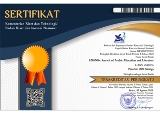Dirāsah Șarfiyyah 'alā al-Kitābah al-'Arabiyyah li al-Lugah al-Jāwiyyah (Pegon) fī Kitāb Fașalātan li asy-Syaikh Raden Asnawi Kudus
DOI:
https://doi.org/10.18326/lisania.v7i2.178-197Keywords:
pegon, arabic morfology, the book of fasholatan, raden asmawi kudusAbstract
This study aims to analyze the words of the Pegon script contained in the Book of Fasholatan by Raden Asnawi Kudus with the perspective of one branch in modern linguistics, namely morphological studies. In this study, researchers used qualitative research methods based on literature research with content analysis of the contents of the Book of Fasholatan by Raden Asnawi Kudus. The results of this study found that there are several morphological characteristics of the word Pegon in Kitab Fasholatan, namely: First, that the morphological system of Pegon vocabulary is based on the morphological system of Javanese which divides types of words into 11 words. Secondly, in the morphological system of the word Pegon there are several vocabularies absorbed directly from Arabic. Third, in the morphological system of the Pegon script, there are Arabic loanwords that have undergone changes in form and changes in meaning, through various types of changes, namely: phonological changes, changes by adding letters at the beginning of words, in the middle or at the end of words, and changes by removing letters from a Pegon word. Fourth, in the morphological system of the Pegon script, various Javanese dialects including the Javanese dialects of Ngoko, Krama Madya, and Krama Inggil are also used in writing the vocabulary of the Pegon script.







